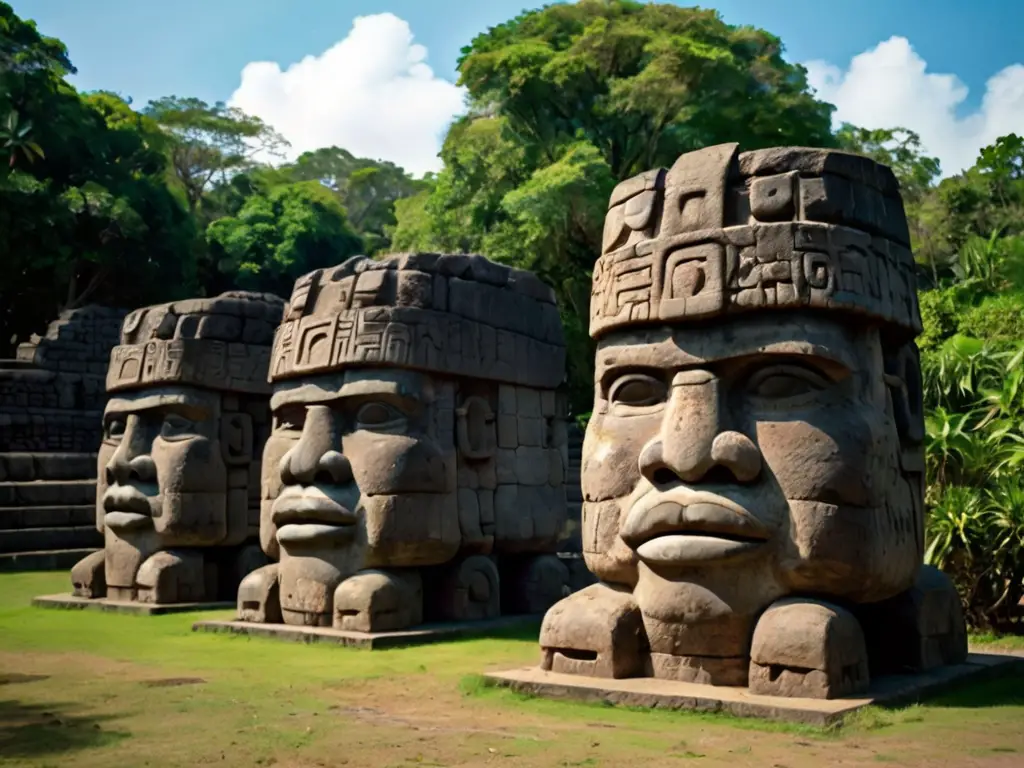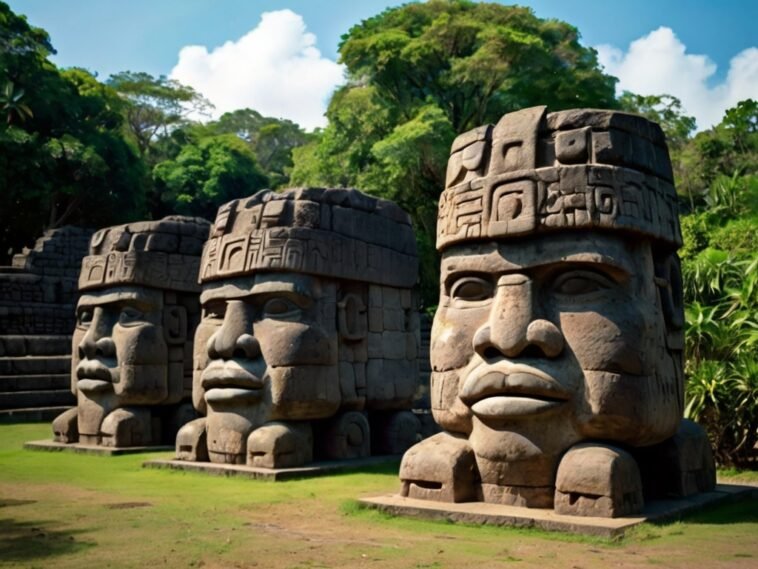
The Olmec civilization, often referred to as the “Mother Culture” of Mesoamerica, laid the foundation for many of the region’s later cultures, including the Maya and the Aztec.
Flourishing between 1200 BCE and 400 BCE, the Olmecs were one of the earliest complex societies in what is now Mexico.
They are best known for their colossal stone heads, sophisticated art, and religious symbolism, but their impact goes far deeper.
This article explores the origins, culture, economy, cities, and the lasting legacy of the Olmec civilization.
Origins and Development
The Olmecs originated in the tropical lowlands of the modern-day Mexican states of Veracruz and Tabasco.
This region, rich in rivers and fertile soil, made it ideal for agriculture, allowing the Olmec civilization to develop and sustain itself.
Evidence suggests that the Olmecs began as a small agricultural society around 1600 BCE, cultivating crops like maize, beans, and squash.
By 1200 BCE, the Olmecs had established their first major city, San Lorenzo, which became a political and ceremonial center.
Over the next several centuries, the civilization expanded, giving rise to additional cities such as La Venta and Tres Zapotes.
The development of these cities reflects the growth of a complex society with advanced political, religious, and economic structures.
- Read also: Unveiling the Mesoamerican Calendar System: A Journey Through Time
- Read also: Deciphering the Glyphs: The Mesoamerican Writing Systems
Olmec Culture and Society
The Olmecs are renowned for their rich culture, which heavily influenced later civilizations.
Religion played a significant role in Olmec society.
They practiced shamanism and believed in a world filled with supernatural forces.
The Olmecs were polytheistic, worshipping a range of gods, many of which were depicted as hybrids of humans and animals, such as the Jaguar God, a prominent figure in their belief system.
The colossal heads, one of the most recognizable features of Olmec culture, are believed to represent rulers or important figures in their society.
These massive sculptures, some standing over 9 feet tall and weighing several tons, were carved from volcanic basalt and transported over long distances, showing the Olmec’s advanced organizational skills.
Art and symbolism were key elements of Olmec society. Jade, a highly valued material, was used to create intricate figurines and masks, often associated with religious and ceremonial purposes.
The Mesoamerican Ballgame, a ritualistic sport thought to have originated with the Olmecs, would later be adopted by the Maya and Aztec, showcasing the Olmec’s profound cultural influence.

Olmec Economy and Trade
The Olmec economy was predominantly based on agriculture, particularly the cultivation of maize, which was central to their diet.
However, they were also skilled craftsmen and traders, and their influence extended far beyond their core region.
The Olmecs developed trade networks that spanned across Mesoamerica, trading goods such as obsidian, jade, rubber, ceramics, and animal pelts.
Olmec jade artifacts have been found as far as present-day Guatemala and Honduras, evidence of their far-reaching trade connections.
This trade not only allowed for the exchange of goods but also facilitated the spread of Olmec cultural and religious practices across the region.
According to a study published in Ancient Mesoamerica, the Olmec civilization was instrumental in establishing long-distance trade routes that became essential for later Mesoamerican societies.
Olmec Cities and Monuments
The most well-known Olmec cities are San Lorenzo, La Venta, and Tres Zapotes.
Each of these cities served as political, economic, and religious hubs for the Olmec people.
San Lorenzo
As one of the earliest Olmec centers, San Lorenzo flourished from around 1200 BCE to 900 BCE. It was home to numerous ceremonial structures, large platforms, and terraces.
The city is perhaps best known for its monumental stone heads, which are thought to represent rulers or deities.
La Venta
After the decline of San Lorenzo, La Venta became the center of the Olmec civilization around 900 BCE.
This site is particularly famous for its massive pyramidal structures, believed to be the precursors to the pyramids built by later Mesoamerican civilizations.
La Venta also contained numerous stone monuments, altars, and tombs, many of which reflected the Olmec’s religious beliefs.
Tres Zapotes
This city continued to be an important center of Olmec culture after the decline of La Venta.
It is notable for being the site where the last known Olmec colossal heads were found, signaling the tail end of the civilization’s artistic and political power.

Decline of the Olmec Civilization
The decline of the Olmec civilization, which flourished in ancient Mesoamerica, remains a bit of a mystery.
Around 400 BCE, their major cities, like La Venta and Tres Zapotes, started falling apart, and the civilization gradually lost its influence.
Although we don’t know for sure why the Olmecs faded away, archaeologists have suggested a few possible reasons:
Environmental factors
Changes in the environment may have affected the Olmecs’ ability to farm and support their population.
For example, rivers may have shifted or droughts may have occurred, making it harder for them to grow food.
This could have led to food shortages and forced people to abandon their cities.
Internal conflict
Some researchers believe that the Olmec civilization may have been weakened by internal problems.
Power struggles between different leaders or conflicts among the city-states could have destabilized the society, making it harder to stay united.
External pressures
Invasion or competition from neighboring cultures might have also contributed to the Olmecs’ decline.
As other civilizations rose in the region, the Olmecs may have faced increased pressure that they couldn’t withstand.
The Olmec legacy
Even though the Olmec civilization eventually disappeared, their influence lived on.
They set the foundation for many aspects of later Mesoamerican cultures, like art, religion, and societal structure.
Olmec Legacy and Influence
The Olmec civilization had a profound influence on the development of later Mesoamerican cultures, including the Maya, Zapotec, and Aztec.
Many of the hallmarks of Mesoamerican civilization, such as monumental architecture, complex religious beliefs, and the Mesoamerican ballgame, can be traced back to the Olmecs.
Olmec artistic styles and iconography continued to be used by later cultures, especially the distinctive use of jade and the depictions of human-animal hybrid gods.
The influence of Olmec religion is seen in the worship of deities like the Feathered Serpent, a figure that became central to both Maya and Aztec theology.
Additionally, the Olmecs are credited with the development of early forms of writing and calendrical systems that would later be refined by other Mesoamerican civilizations.
These contributions demonstrate the far-reaching and lasting impact of the Olmec civilization on the entire region.

- Read also: Decoding the Stars: Mesoamerican Astronomy and Astrology
- Read also: A Journey Through Time: The Mesoamerican Civilizations Timeline
Final Thoughts
The Olmec civilization, while shrouded in some mystery, stands as a monumental force in the history of Mesoamerica.
From their architectural achievements and artistic innovations to their religious and cultural influence, the Olmecs laid the groundwork for many of the region’s most important cultural developments.
While their civilization may have declined by 400 BCE, their legacy continues to be felt in the history and culture of Mexico and beyond.



